February 9, 2015
How I Spent My Teen Years
Whenever I do a Q&A with a band, inevitably somebody asks me:
“What instrument do you play?”
When I answer, “none,” there’s skepticism, and then the logical follow-up question, “how did you get into writing music if you never played an instrument?”
The answer is that I have always used a computer – from the time I was really young. My grandfather was an amateur musician who played clarinet, oboe, and flute in community orchestras – and in the Army years before that – and who, as a career, owned a music store and repaired instruments. One afternoon, when I was about 11 years old, he showed me how to write music using a music program on his Apple IIe – a program called Music Construction Set. You’d grab rhythmic values from the bottom of the screen, drag them to the piano staff using a joystick (yes, a single-button, Atari 2600-style joystick), and then press “FIRE” on the piano icon, and your music would play. Here’s one of the original demos from that software:
I had nothing to do with that demo, so I can’t take credit or responsibility for the ending!
My dad got me a Commodore 64 for my birthday that year, and I got my own copy of Music Construction Set for Christmas, and started writing music. I mean, “music.” It was awful, and none of that earliest stuff survives. The software was incredibly limited, as you can see from the above example. It couldn’t play triplets, unless you wanted what I call “marching band triplets” – dotted-8th, dotted-8th, 8th. Sounds and tempo had to be consistent throughout the piece, and – worst of all – so did time signatures! I’m still trying to right that wrong with pieces like “Wine-Dark Sea.”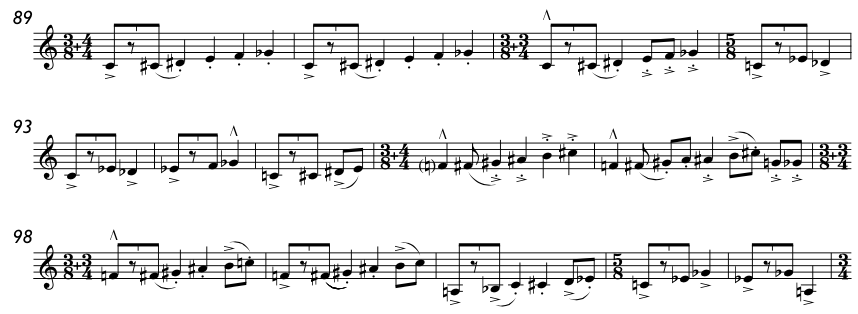
Before long, I got a new program called SidPlayer. This program allowed much more control over the three voice sound chip in the computer. (Yes, I was limited to only three notes at a time.) I could change meters, tempo, and sounds. I could approximate articulations or vibrato. I could “fake” a crescendo by programming a slow attack value for a note. As an 11-12 year old, it felt like I could do just about anything. The editor looked like this: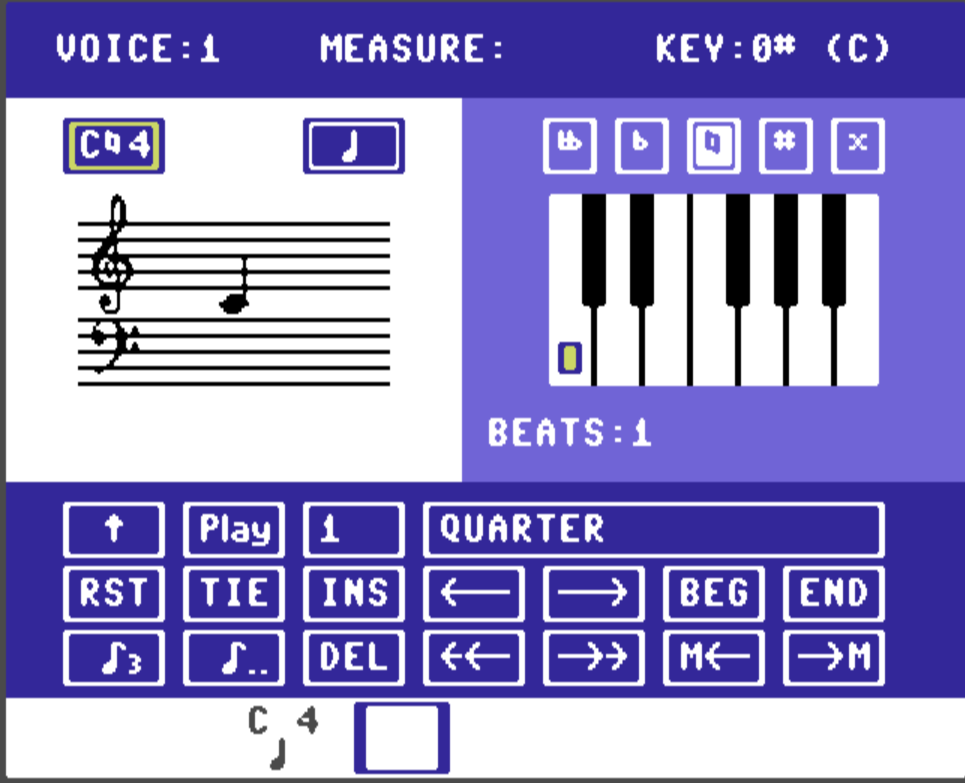
Mostly, at that age, I didn’t write my own music – but I did write some. Here’s my earliest piece. There was apparently something before this – I indicated this was “opus 2!” – but in my memory, this was really the first piece. (Maybe “opus 1” was everything I wrote in my early pre-12 years?) I wrote this for my grandfather (intending him to play the clarinet part). The movie “Amadeus” had just come out, and I was obsessed with it, so I wrote a “Lacrimosa.” I seemed to think it was in Bb minor because the key signature had 5 flats, but it’s in Eb dorian. Go easy on me – I was 12 (and no Mozart). Also, I have no idea why I didn’t try to make the “clarinet” sound like a clarinet.
It went on a little from there, but you get the idea, and there’s no need to make you suffer through more of a 12-year-old’s idea of angst.
Here’s a piece I wrote in 8th grade, when I was 13 years old. I still kind of like it – especially for being by a 13-year-old dork. Abby thinks I should use take this tune I wrote in middle school, transform it, and use it as the tune for a middle school piece I’m about to write. I think I just may do that. I kind of love the idea of a piece for middle school kids using material written by the composer when they were actually in middle school.
When I wasn’t writing my own music (or “music”), I went to the library and checked scores out, took them home, and painstakingly programmed that music into the software – again, using a joystick. In SidPlayer, you’d edit one voice at a time – you couldn’t see the other voices while editing a voice. That’s probably why I write so many ostinatos now (and why my publishing company is Osti Music) – because it was easier to keep a repeated figure in my head while I wrote a new layer on top of that layer (being unable to actually hear the first layer while writing the second). I mean, you hear nothing but loops in that above piece.
So I’d select a voice, slide the joystick up or down a piano staff until you got to the pitch I wanted, move the joystick left or right to select the rhythm, then press FIRE and the note would be entered. Repeat. Repeat. Repeat. Imagine doing this for a three-part Bach fugue, and it’s not so bad:
(That’s maybe my favorite Bach fugue – largely because of the jazzy little ending.)
That 2 minutes probably took a day to enter – and I programmed all six Bach Brandenburg Concertos this way. (That link is to my arrangements of the complete Brandenburgs. You’ve been warned.) That alone is about 90 minutes of music. It never sounded “good,” but it was an incredible way to learn about music — voice leading, transposition (since I had to manually transpose the instruments – and those Brandenburgs had some unusual horn and trumpet transpositions), and arranging (since I had to reduce pieces to 3 maximum notes at once).
I programmed a ridiculous amount of music into this software. The last movement of the Dvorak Cello Concerto. The complete “Peter and the Wolf” by Prokofiev. The first movement of the Haydn D Major Piano Concerto. The complete Barber Violin Concerto, and the first two movements of his piano concerto – and the Adagio for Strings. (You haven’t truly felt pain until you’ve heard an 8-bit computer playing Barber’s “Adagio for Strings” as interpreted by a 15-year-old.) I programmed most of the Poulenc Gloria. I even programmed the complete “Pictures at an Exhibition” by Mussorgsky. Yes, it sounded awful, but it was fun, and without trying, I was learning a lot about music.
I mentioned that the Commodore 64 could only play three notes at a time. I eventually got a SECOND Commodore 64, hooked one up to each of the two stereo channels on my receiver, hit the space bar on both at the same time, and got SIX GLORIOUS 8-BIT SOUNDS AT ONCE! Shortly thereafter, a cartridge became available that contained a second sound chip, so everything could be done with a single computer. WOW! Six notes at once on ONE COMPUTER!!!
Here’s the first movement of Leonard Bernstein’s “Chichester Psalms,” as sequenced by me when I was probably 15 or so. Does it sound good? No, it sounds awful. Plus, I was working from a piano reduction, which assigned the bongos to pitches in the piano part – so I programmed those pitches. But this is the piece that taught me about 7/8. (So, you can blame Bernstein for most of my music.)
Here’s the second movement of Samuel Barber’s Violin Concerto. It’s gorgeous music – but you wouldn’t know it from this. But you can hear that I was trying to make it sound a least a little musical, adding programmed rubato all over the place. And if you’ve heard my piece “Hymn to a Blue Hour,” you’ve heard the piece of mine that is essentially a huge rip off of this piece.
So when somebody says, “this is how you spent your teen years? Not chasing girls, but this?” I have to admit, “I tried chasing girls. They were not interested. So I spent a lot of time playing with my joystick.”
July 22, 2014
New stuff for Fall 2014!
Even though I haven’t written a note of music since February (I’m still on a self-imposed sabbatical, recovering from the seven-months I spent writing “Wine-Dark Sea“), I do have a few pieces that are “new” – or at least newly available for performances this fall. I’ve mentioned all of these at some point on Facebook, but it seemed like maybe there should be a single blog post that covers them all in one tidy, tasty little morsel of a blog post. YUM!
“Wine-Dark Sea: Symphony for Band” – a huge piece – 32 minutes! – based on “The Odyssey” by Homer. (That story lasts 20 years, so compressing it to 30 minutes was not so easy.) It was commissioned by the University of Texas for the 100th anniversary of their school of music, and taken on their recent “Around The World” tour. It’s three movements, and a group can do the whole thing (my first choice, obviously), or a single movement. The first movement, “Hubris,” starts out as an arrogant march (check out the horns!), and gets darker from there. The second movement “Immortal thread, so weak,” is about devotion and a broken heart. The final movement, “The attentions of souls,” is loud and raucous, imagined as a ballet of the shrieking souls of the dead. Believe it or not, even with a description like that, people seem to want to clap when it’s done.
Here’s a video of the University of Texas Wind Ensemble’s performance in Tokyo, conducted by Jerry Junkin.
Next up, two very different pieces. In 2013, I wrote “The Soul Has Many Motions,” a four-movement suite in honor of conductor and educator Richard Floyd’s retirement from UIL in Texas. Last fall, I released one movement – “Night on Fire” (featuring multiple hand percussionists – the more the merrier/louder) as a standalone piece. That movement was just added to the Texas Prescribed Music List. This year, two more movements are available as individual pieces.
First up: “Unquiet Spirits,” the third movement of the suite. This is sort of a limping, melancholy waltz. (If you’re a sax player, you might know this tune as being the same as the tune from the second movement of my saxophone quartet, also called “Unquiet Spirits.”) This piece is probably a grade 4 or 4+. You can listen to the Soundcloud audio here, and find the score here.
The other newly-released standalone movement from the suite is the final movement, a circus march called “The Ringmaster’s March.” Imagine if Charles Ives and I got drunk together and re-wrote Henry Fillmore’s “The Circus Bee.” You can see the score here.
But what if you’re looking for a bigger, more serious piece than a circus march – something in the 9-minute range – but “Wine-Dark Sea” is a little much? Do you have a good band with a few really great soloists — on, say, clarinet and flute? Then I give you: “(Redacted).” Think music about the life of a spy – about both the excitement, but also the loneliness. (Did you catch the great Texas State University performance at CBDNA in March, conducted by Caroline Beatty? Hot damn.) The premiere performance – heard in the Soundcloud link below – was put together in only three days, by the Kappa Kappa Psi / Tau Beta Sigma 2013 National Intercollegiate Band, conducted by Anthony Maiello. (You can download the score here.)
And if you want epic, there’s “The Frozen Cathedral.” It’s been around since March 2013, but wasn’t available to non-consortium-members until January.
Lastly, and this one is not quite new, is “High Wire.” Yes, it premiered back in May 2012, but I didn’t have a video performance of it until this February, when Frank Ticheli conducted it with the Texas All-State Symphonic Band. It’s a four-minute opener with – surprise! – lots of trombone (especially in this performance with, what, 16 trombones? I LOVE TROMBONES.). Download the score for “High Wire” here.
And before we go — Happy Birthday to “Redline Tango!” My first band piece turned 10 years old this year. Don’t you wish you were giving a 10th anniversary performance of the piece? Don’t you? The Hoff thinks you should.
I tried to make that picture the preview pic for the Facebook link to this post. Facebook seemed to think that photo was inappropriate. INAPPROPRIATELY TOO AWESOME, I guess.
Please forgive the horribly tacky self-promotional post. Financing the renovation of a 125-year-old house will drive you to do things you aren’t proud of. I promise that our next posts will return to photos of renovations,
food,
travel (the UT Wind Ensemble on the Great Wall of China!),
or, best of all, cats (preferably high on catnip).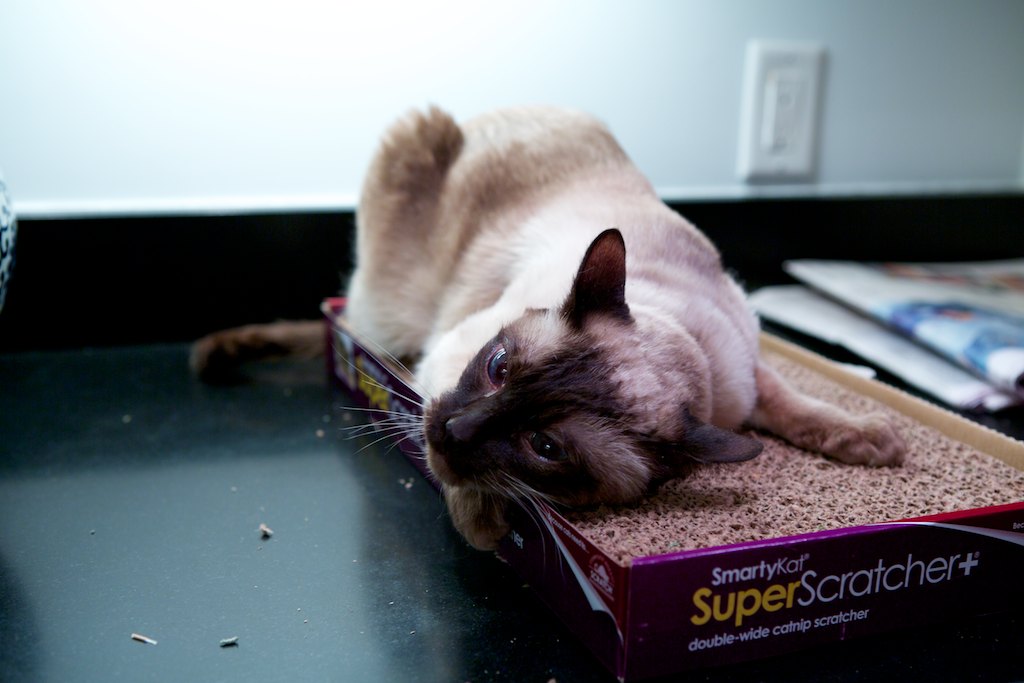
Okay, for sticking it out through this whole post, a bonus: video of composer Steven Bryant (in lederhosen!) playing the suspended cymbal part for my piece “Undertow.”
View Comments
Comments
Add comment
June 2, 2014
UTWE Tour : Shenzhen
We’re two weeks into the Around The World tour with the University of Texas Wind Ensemble. I’ve wanted to post blog posts along the way, but the days have been overflowing with activities. Today is our last day in Hong Kong. We’re off to Beijing in the morning, but in the meantime, I have an hour free to write a post – and yesterday was too great of a day to go without a blog.
We’ve been in Hong Kong since last Thursday. There was a runout concert to Macau on Saturday – a 14-hour day with ferry trips, a dinner, and a concert – and after less than eight hours back at the hotel, we were out the door again, this time heading to Shenzhen, China — our first trip into China – and our first trip through Chinese immigration. Even with dozens of instruments going through customs, the trip was remarkably smooth. A student took this picture with his phone before he saw the sign warning of imprisonment if you took a picture.
How was China different from what we’d experienced so far? For starters, the food was different. I mean, they have GREEN CUCUMBER flavored potato chips, as if they don’t seem to realize that CUCUMBERS ARE THE YUCKIEST FOOD THAT EVER WAS. (Other food in Shenzhen, it turned out, was delicious. Stay tuned.)
The concert was at the Xi Xiang Music Valley Cultural Center. It is in the valley of music – in THE TOWN OF WIND MUSIC! Why doesn’t America have a wind music town??? (Jerry Junkin for Mayor!)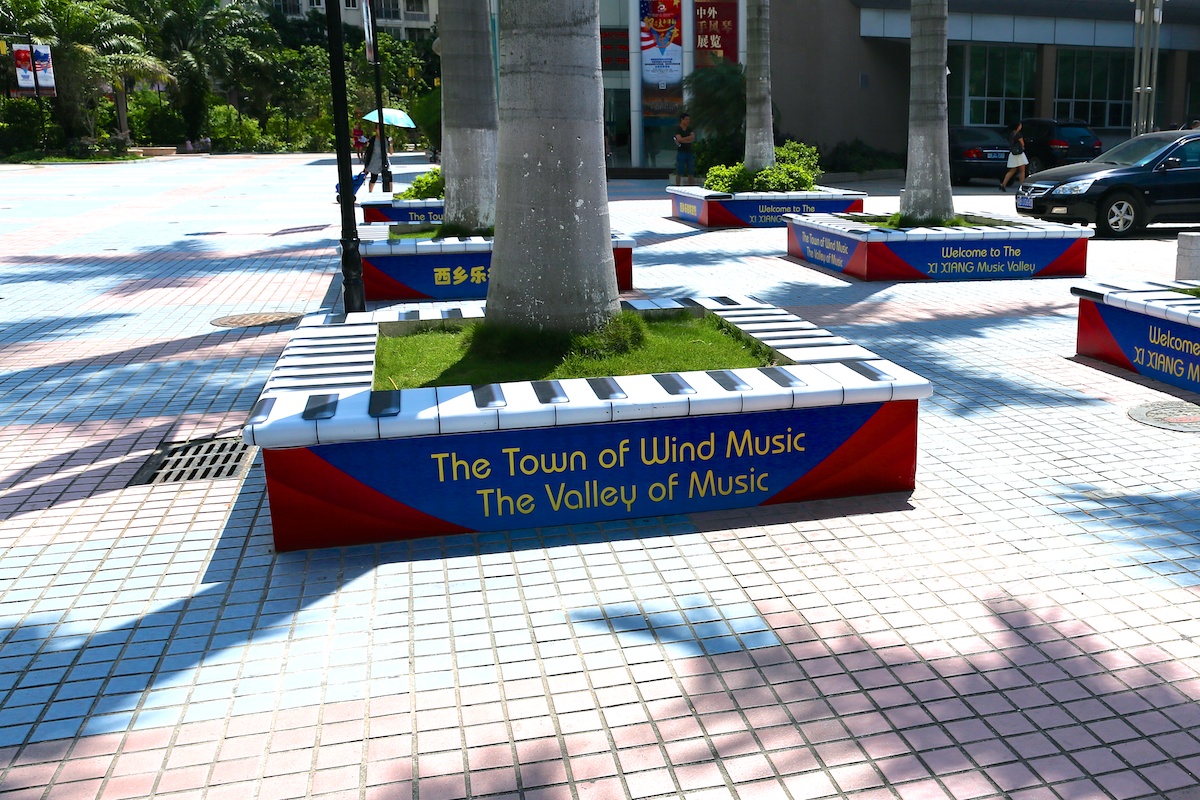
So our busses pull up to the cultural center, and there were all of these kids on the stairs, clapping in rhythm and chanting to welcome us. I’m afraid I have no snarky comment about this because it was a lovely moment.
I mean, they were so excited – and so adorable.
A banner in the lobby welcomed the UT Wind Ensemble, recognizing their status as a top-3 concert band. (Who the hell are numbers two and three?)
The afternoon started with masterclasses, where the UT students worked with students from the area bands.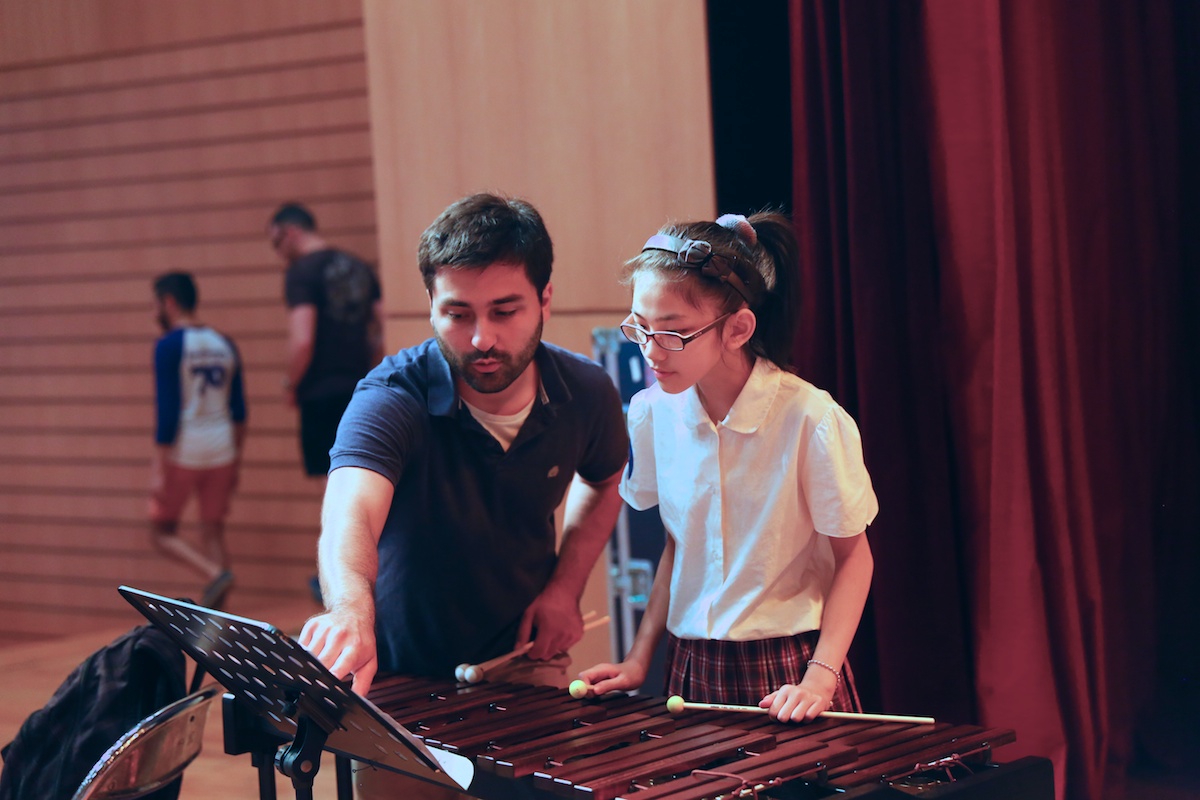
This picture really captures the joy of the entire experience.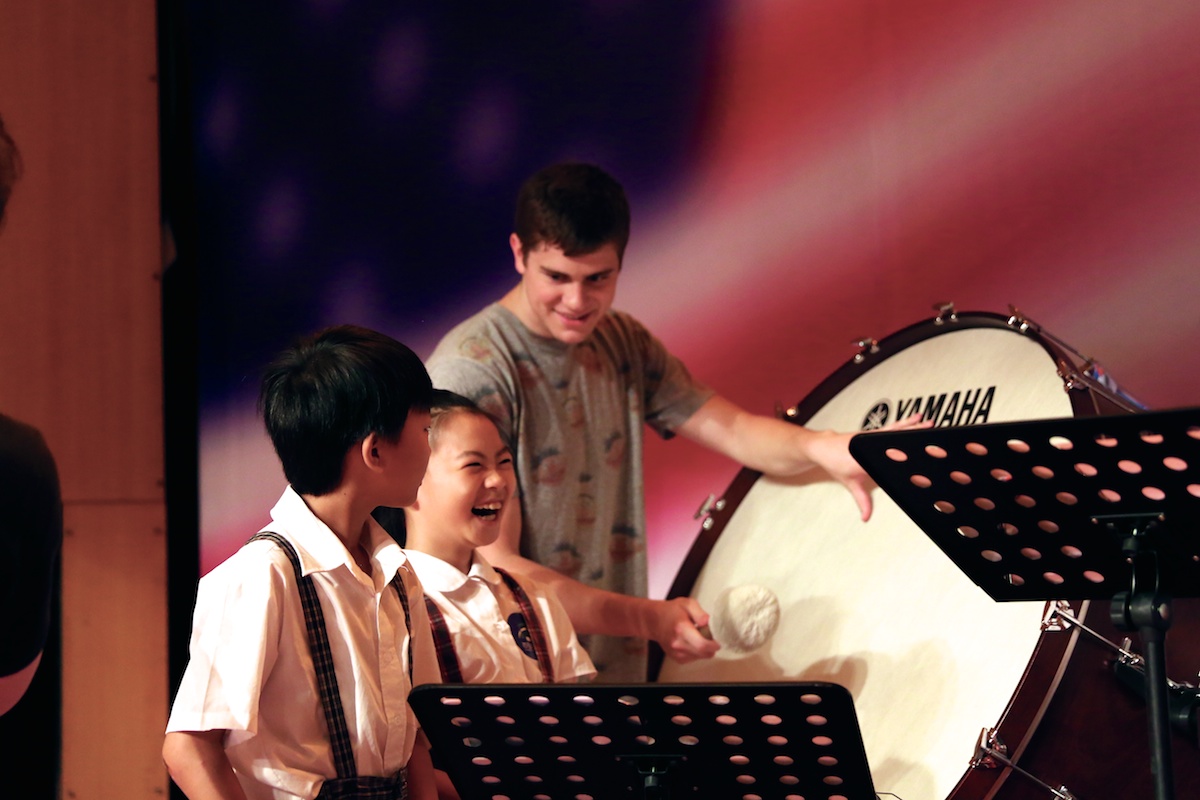
I’ll say one thing about southern China in June: it is hot. This kid had the right idea with those shorts. (I also love that he’s smaller than his horn.)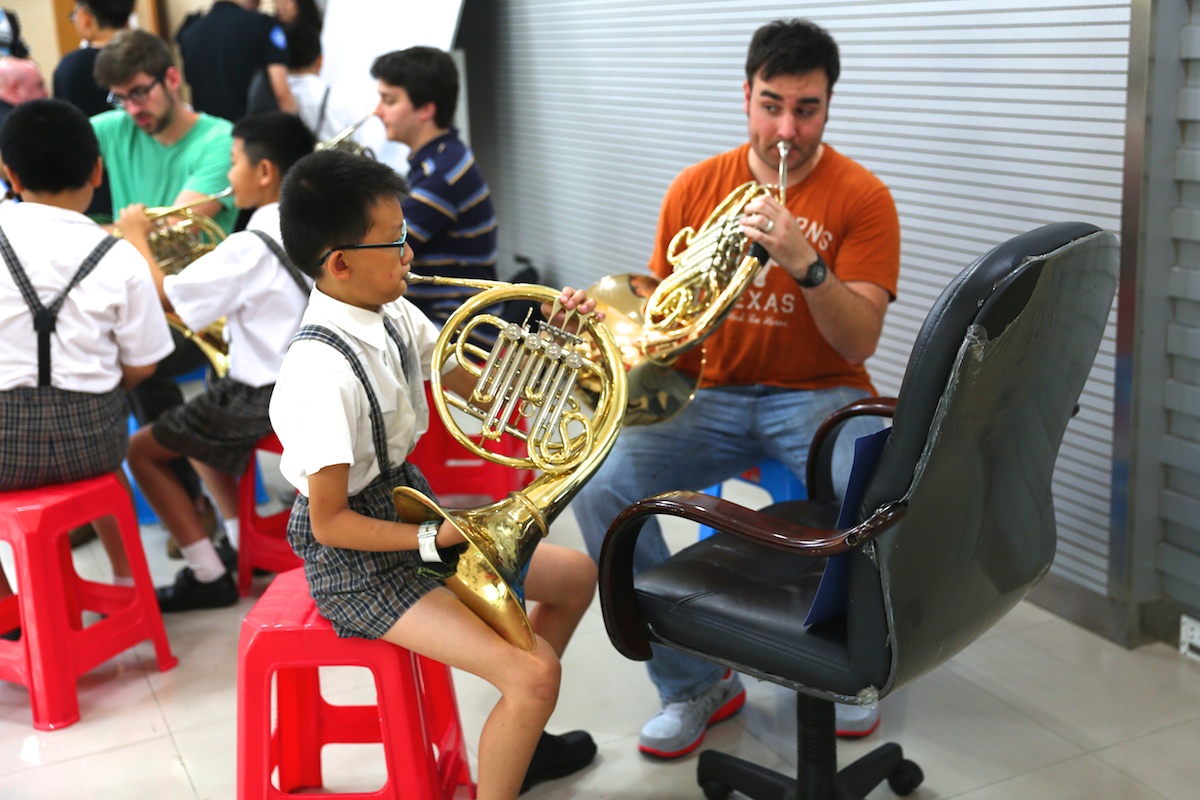
Fun with oboes.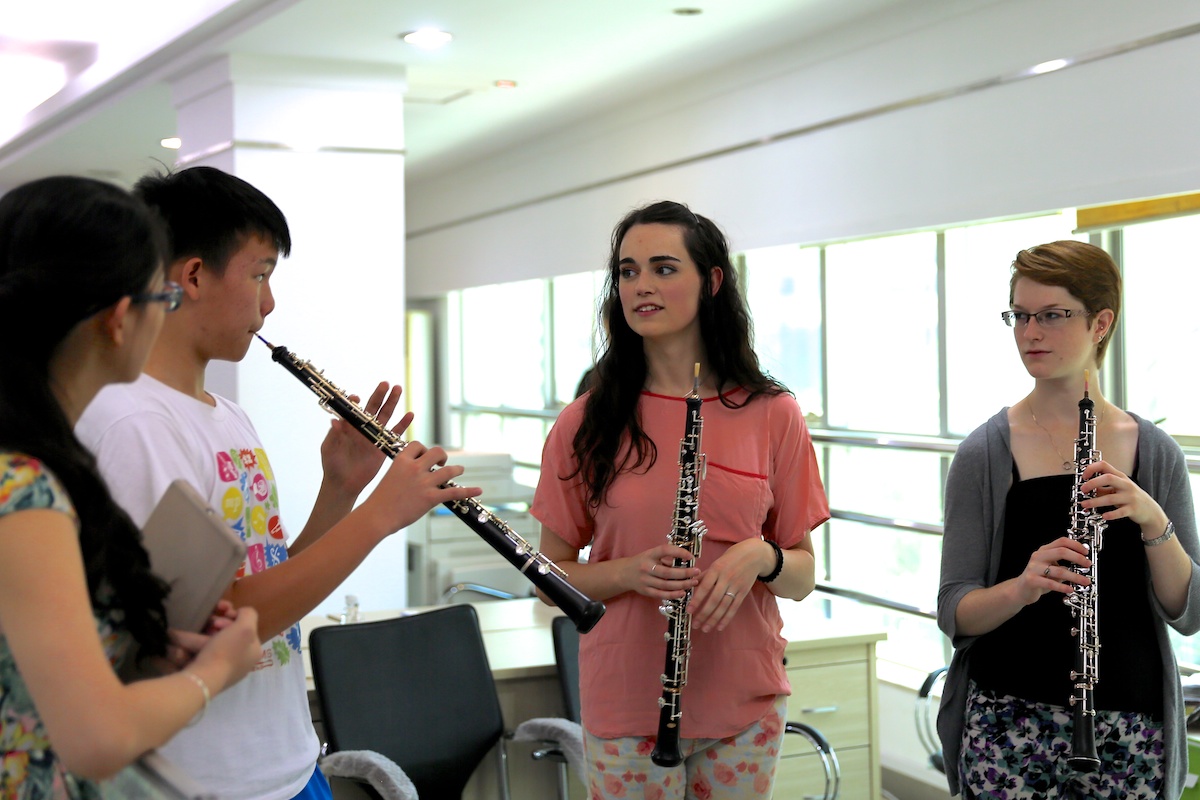
But what brings on smiles more than a bass drum? (The kid on the left was later spotted wearing his tambourine as a hat, which I’m now going to require in my next piece.)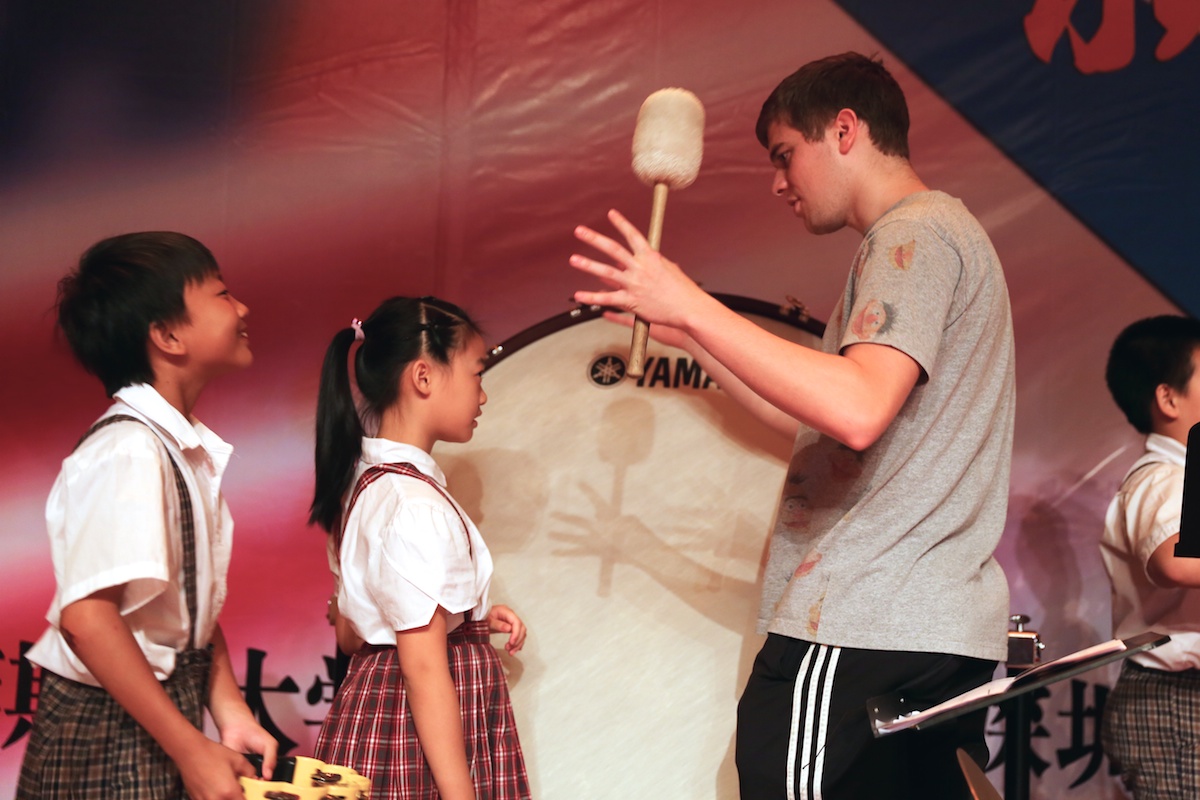
It was almost concert time! China is a culture where smoking is pretty common, so this sign hanging inside the concert hall was actually somewhat necessary. I want this sign for inside of our house.
When concert attendees arrived, they received programs and flags for both China and the US.
The crowd — standing-room by the time the concert started — was pretty excited to see the UT Wind Ensemble. The concert even had two emcees – one speaking Chinese, the other (the woman in the super sparkly gown) translating to English.
There were dozens of people filming the concert with their phones. As one UT musician said after the concert, “if China had YouTube, we’d all be famous!” Here, an audience member films Nathan Williams – the UT clarinet professor – during his wonderful performance of Frank Ticheli’s clarinet concerto.
Some audience members took the concert filming just a LITTLE over-the-top.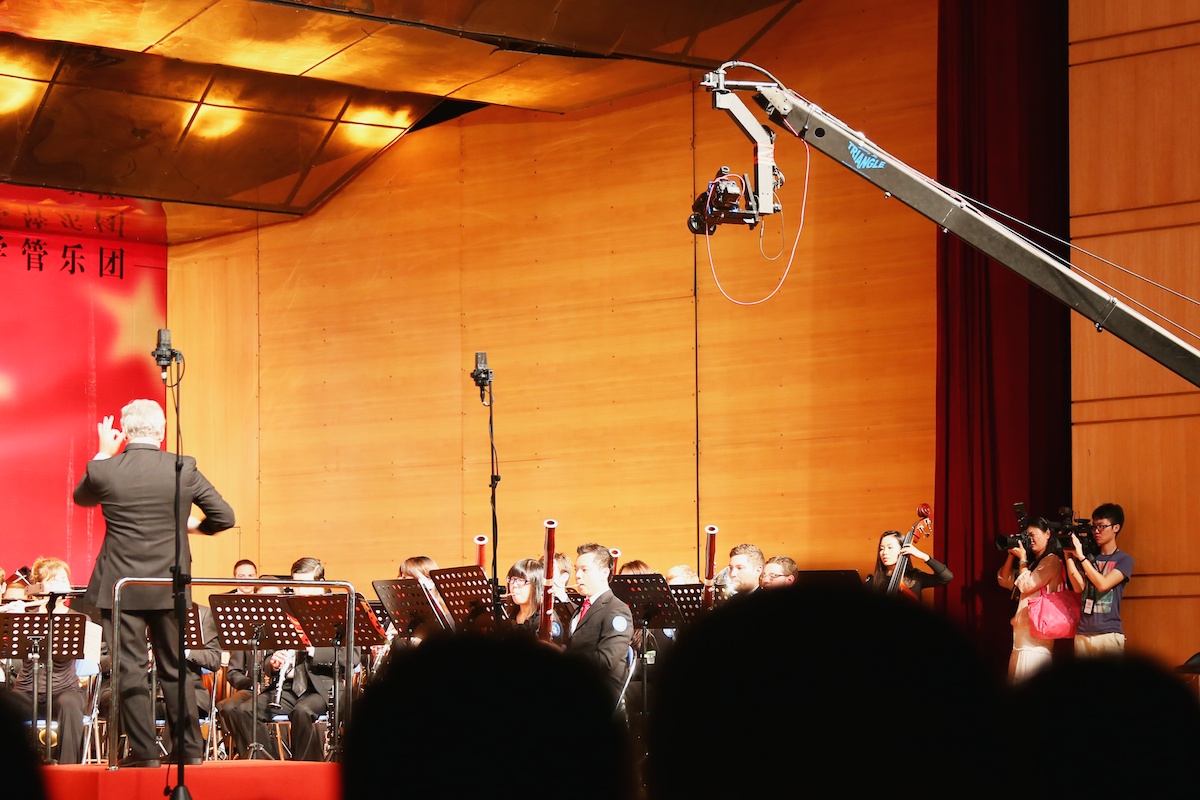
The performance of “Wine-Dark Sea” was the most energetic yet. Like, blow the roof off the joint energetic.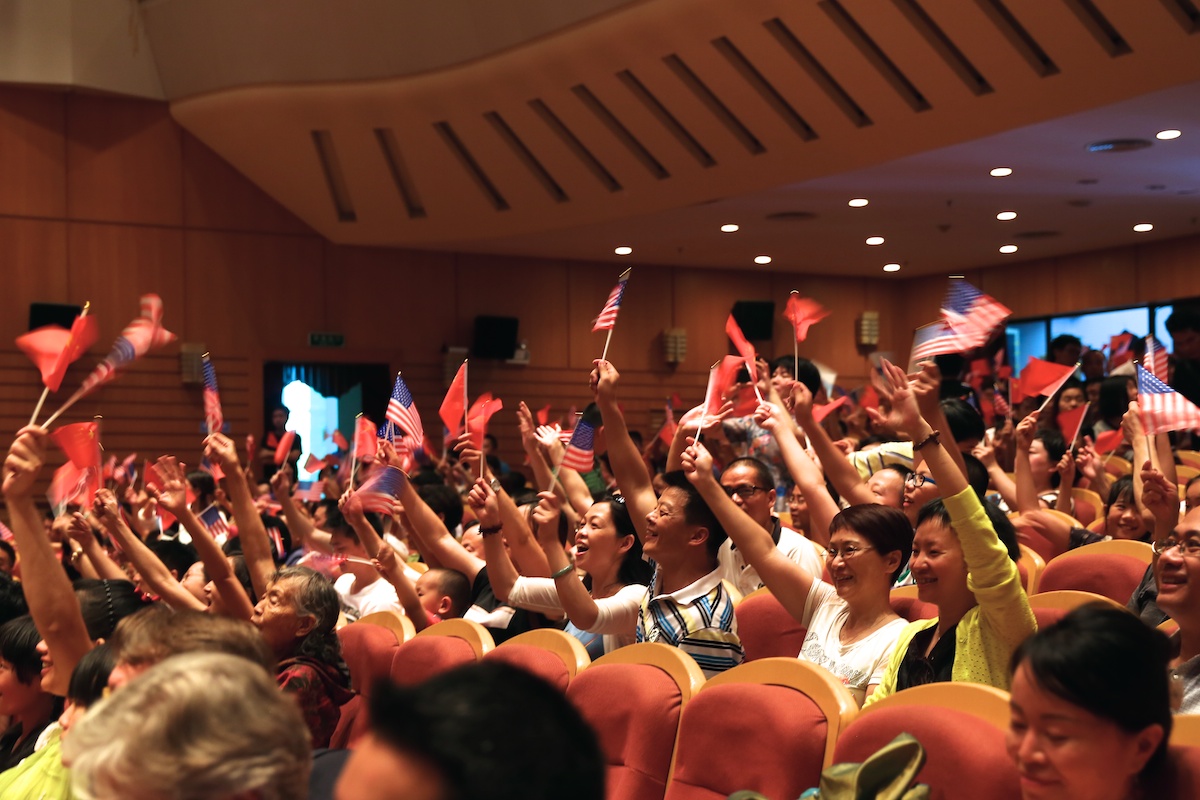
The encores followed, and in a first, Nathan Williams joined the clarinet section. (He’s the clarinetist with a beard.)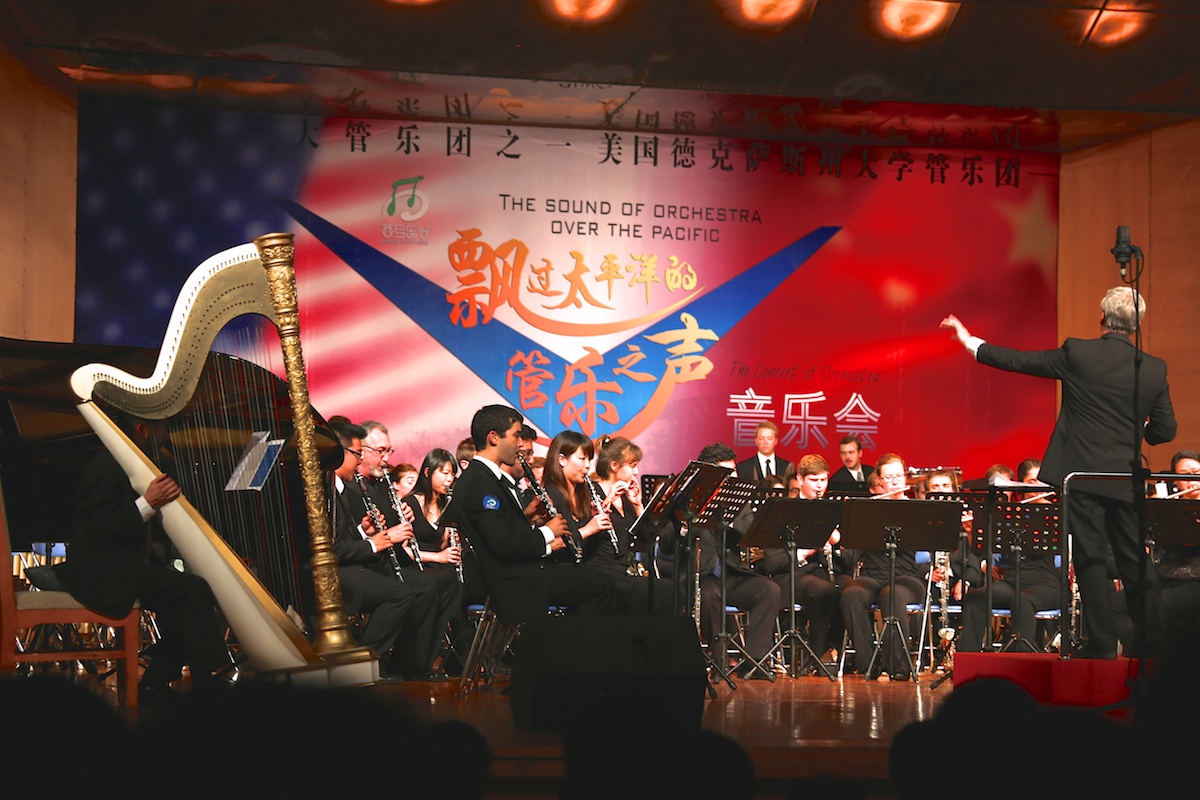
One of the encores was “The Stars and Stripes Forever” (of course). Jerry Junkin spontaneously — shortly before the “piccolo break” — went out into the audience and invited a kid up on stage to help him conduct. It was an amazing moment – in a day of beautiful moments.
Here, the kid takes his well-deserved bow.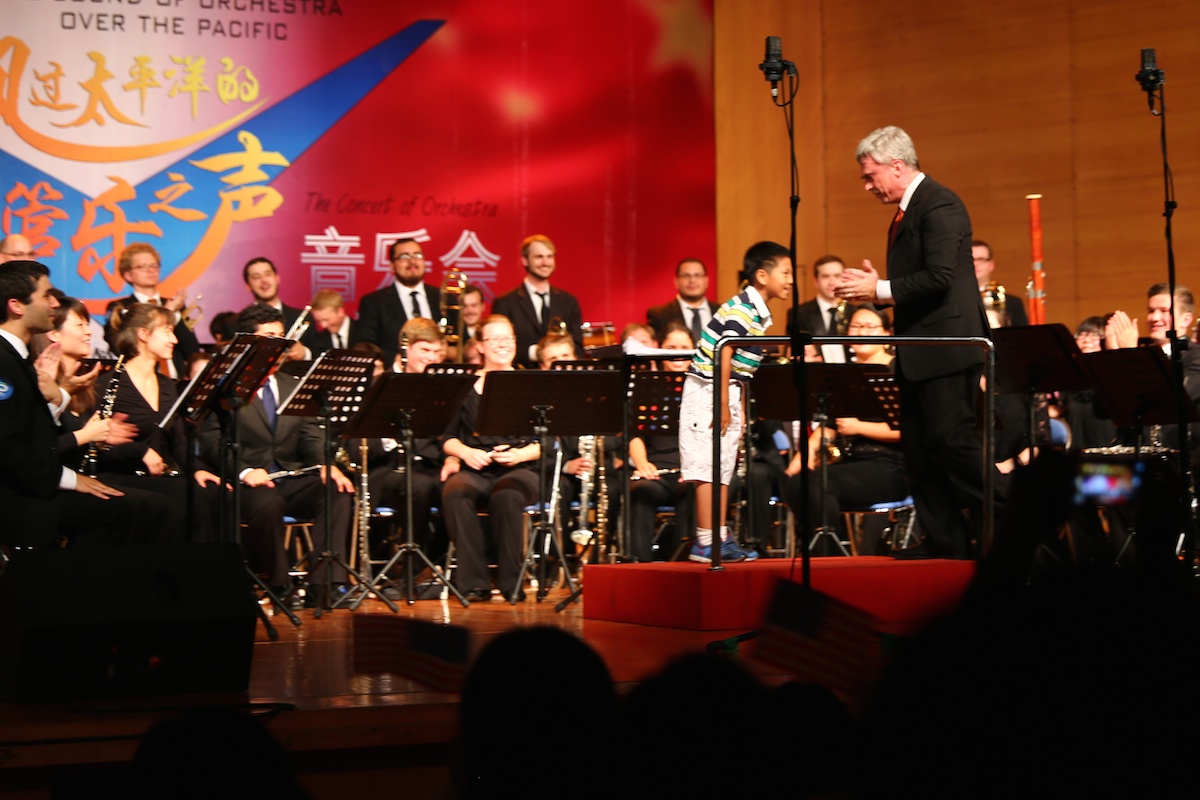
The final encore brought dozens of area young players to the stage for a final joint piece. Here, they all bow together.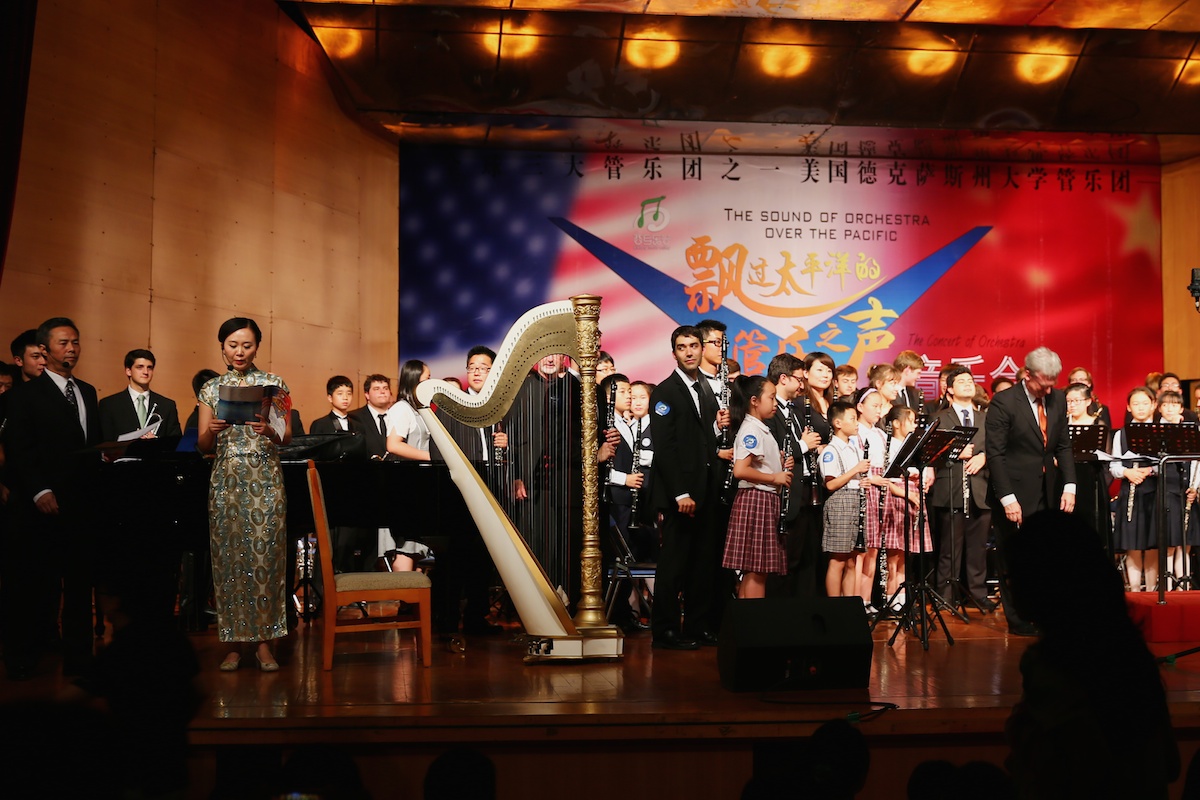
Many curtain calls later, it was time for… Dumpling Party!!! The dumplings were delicious. During the meal, we were treated to performances by area musicians playing traditional Chinese instruments.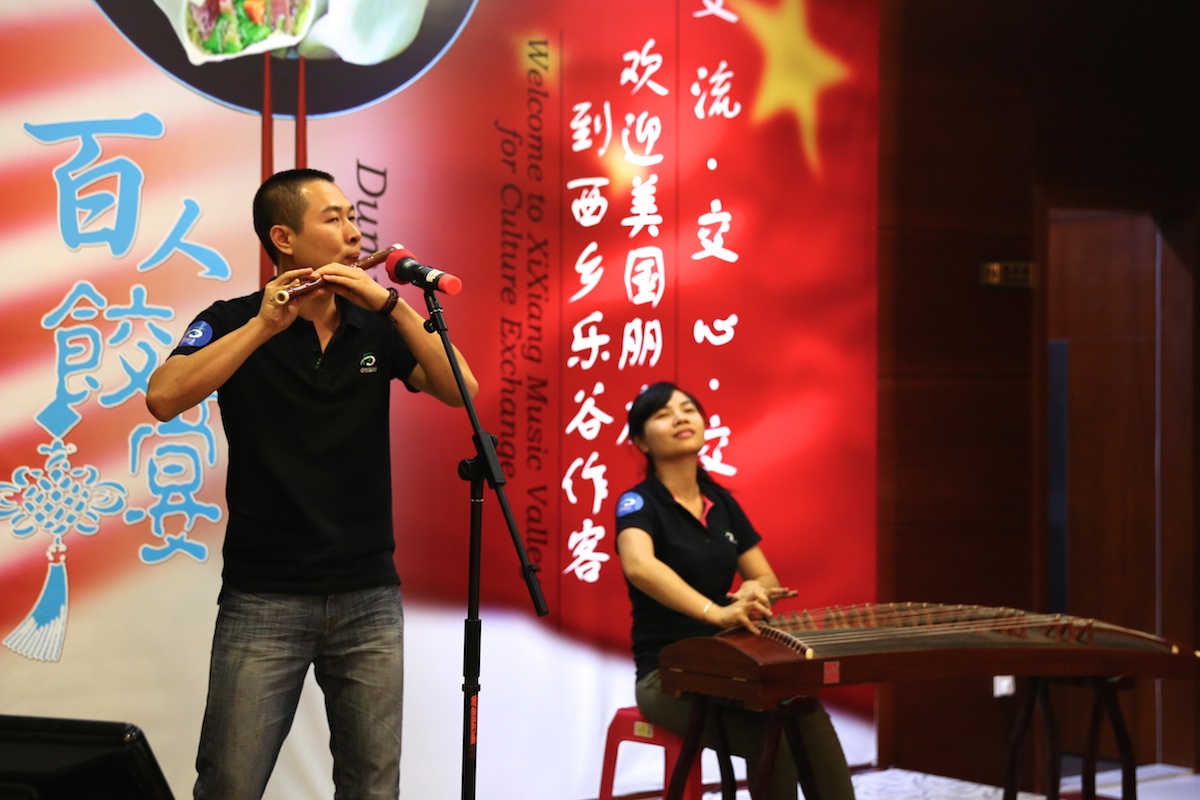
Vincent Pierce, the UT harpist, takes video notes.
Here, a local woman plays an erhu – an instrument that, before last night, I had only heard played by a 75-year old man on the NYC Times Square subway platform. This was… better.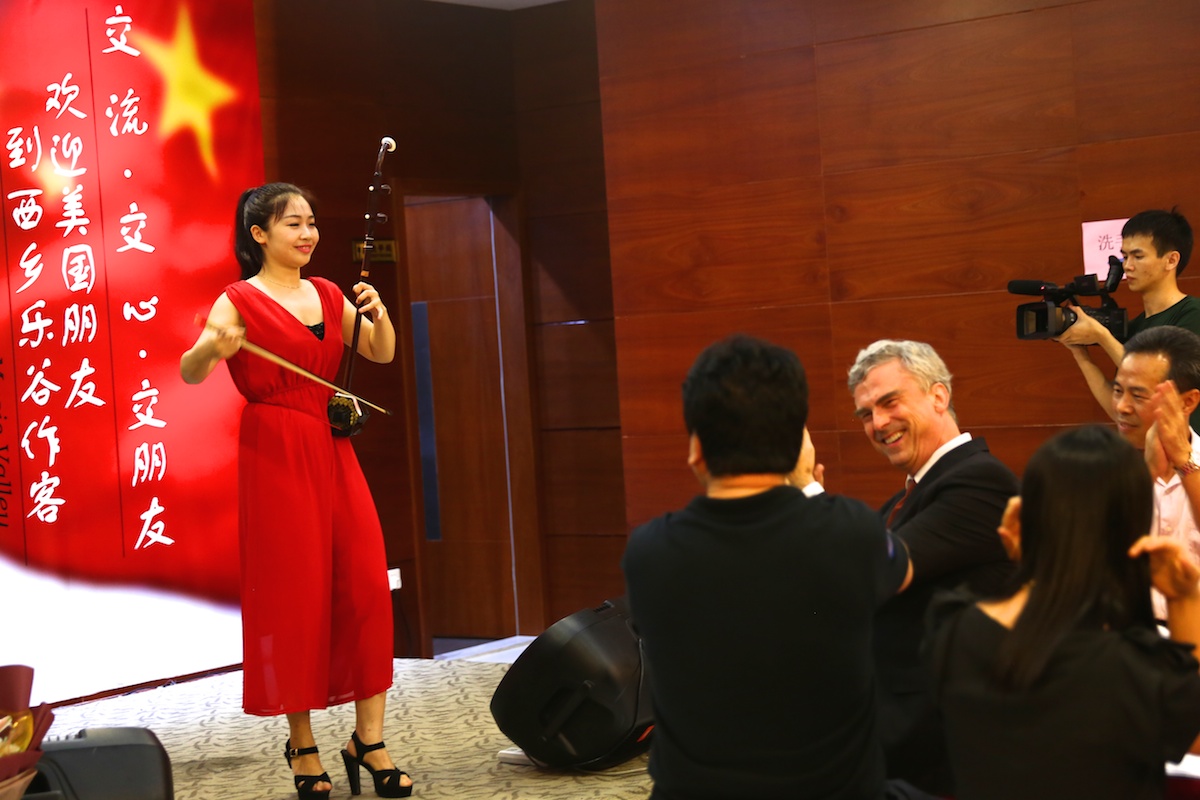
It was a great post-concert party. The beer didn’t hurt.
Then it was time for karaoke! Here, flutist Meekyoung Lee and clarinetist Nick Councilor sing “I Will Always Love You.”
Nick’s teacher, Nathan Williams, sums up their performance perfectly.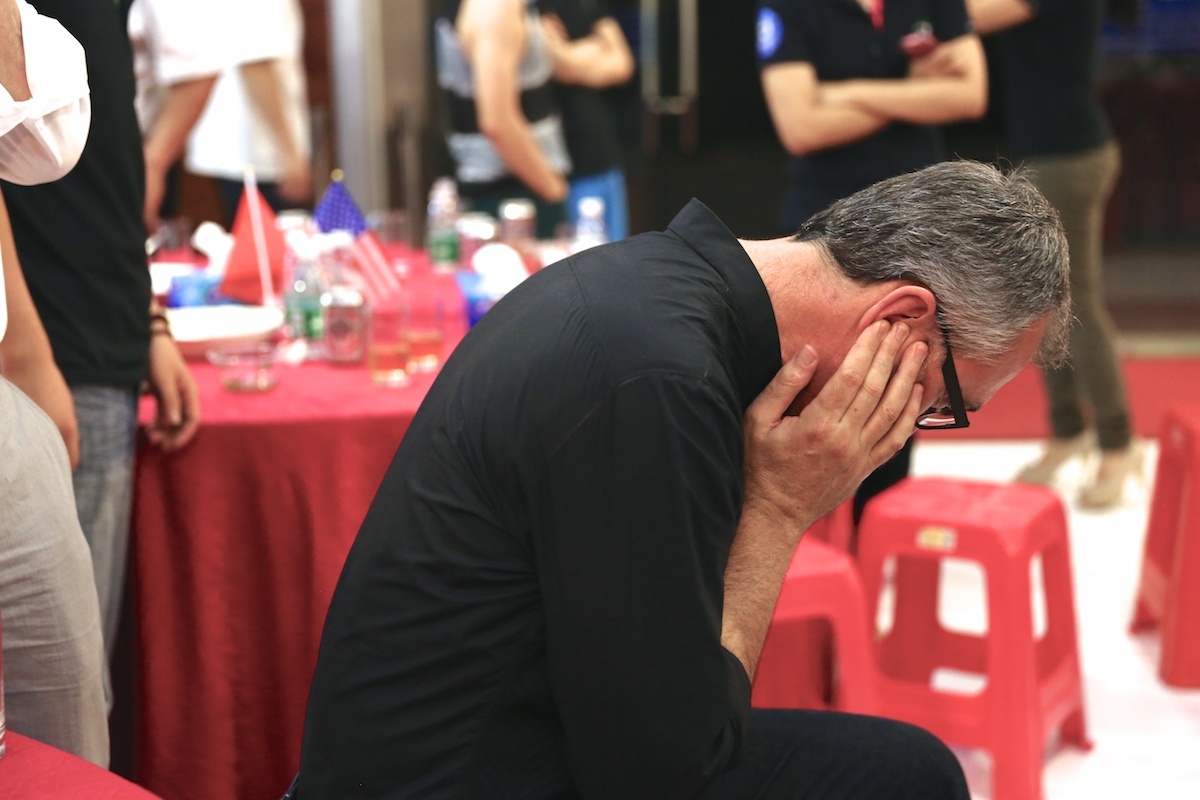
It was a perfect day, from start to finish. I can’t say enough to thank our host, Joseph Cheung. So, we’ll settle for a toast.
Thank you, Shenzhen, for a wonderful experience. And also, for the beer.
View Comments
Comments
Am guessing Number two is Tokyo Kosei Wind Orchestra and Number Three is The Glasgow Wind Band, Britain's Finest according to Phillip Sparke , or possibly Dallas Wind Symphony?
View Comments
Comments
Jessie At Home says
This makes me giggle.
As one of my other old HS friends pointed out to me, we were clueless in HS. There were more girls interested in you than you realized, John. I seem to remember several friends of mine going all doe~eyed when you were around.
But, it all works out the way it is supposed to in the end. :)
Aaron richards says
Loved the barber! One of my favorite pieces and it was so awesome to hear it in that way, see you at TMEA!
Aaron richards says
Loved the barber! One of my favorite movements ever and was awesome to hear it in that way, see you at TMEA!
Hunter says
When i was in middle school/a freshman in high school (06-09) i had this midi guitar tablature program called tabit. its website a lot of people would post tabs every day of not only tab outs of classics and random tunes and dittys and all sorts of things (with midi guitars and way more than all you had of course). The almost forumy culture of that website and how simple it was and so many things getting posted and the rating system, it had a serious impact on my development as a songwriter and i definitely relate to. the site now is dead but this post has made me redownload the software and listen to all my old weird stuff. great read.
Jonathan says
I feel like we all have these kinds of stories. I remember when I first got Finale Notepad 09. I wrote probably thirty bassoon duets because I like bassoons. I did the same for trombones and violins and basically every instrument I didn't understand. It is really strange to stop and look back at all the old stuff, genesis. I remember rewriting the Jurasic Park and Harry Potter themes (was a big John Williams fan) for various instrumentations just to see what it sounded like. And though I would like to say I've matured as a composer from middle school until now, at the end of the day I'm still just a kid fucking around on his laptop. But I guess I still have plenty of time to grow out of that!
Ola says
Hors Concours sounds exactly like, and if I may hazard a guess, might be just a little bit influenced by 80s arcade music. Theme from an imaginary horse racing game? (I'll get me coat.)
Sarah says
Okay, this peek into your early years is interesting, but 6 months ago you promised photos of your house renovation. Come on!
Kerry J. Gilliard says
Your story reminds me a bit of how I ended up training my ear (almost 'perfect' pitch). Strange musical things happen to 10-14 year olds.
Nicholas Gioletti says
Which would you say your favorite instrument is?
I've listen to your incredibly characteristic music lately and I'm stunned that you're able to use every single instrument in the ensemble so well!
Do you have a favorite at all?
Aaron says
Such an interesting and inspirational story of how you got into composition! I try to compose a few things as well but they certainly don't come close to the quality of your music. Really hope I can write a song that's anywhere near half as good as anything you've ever written one day!
Luis R says
That last line was perfect. I know what you mean.
Jon M. Hamilton says
As a young composer myself (19), I find this very inspiring and motivating. Lots of my music is inspired by by what you write and how you orchestrate chords. I'm a very big fan of dissonance. I find it more beautiful and intriguing than regular 1-3-5 chords and other basic chords.
Reading your story really gave me a boost!
Thanks, Mr. Mackey!
Add comment